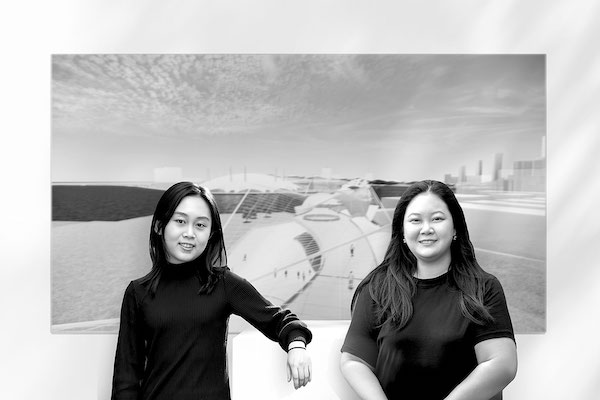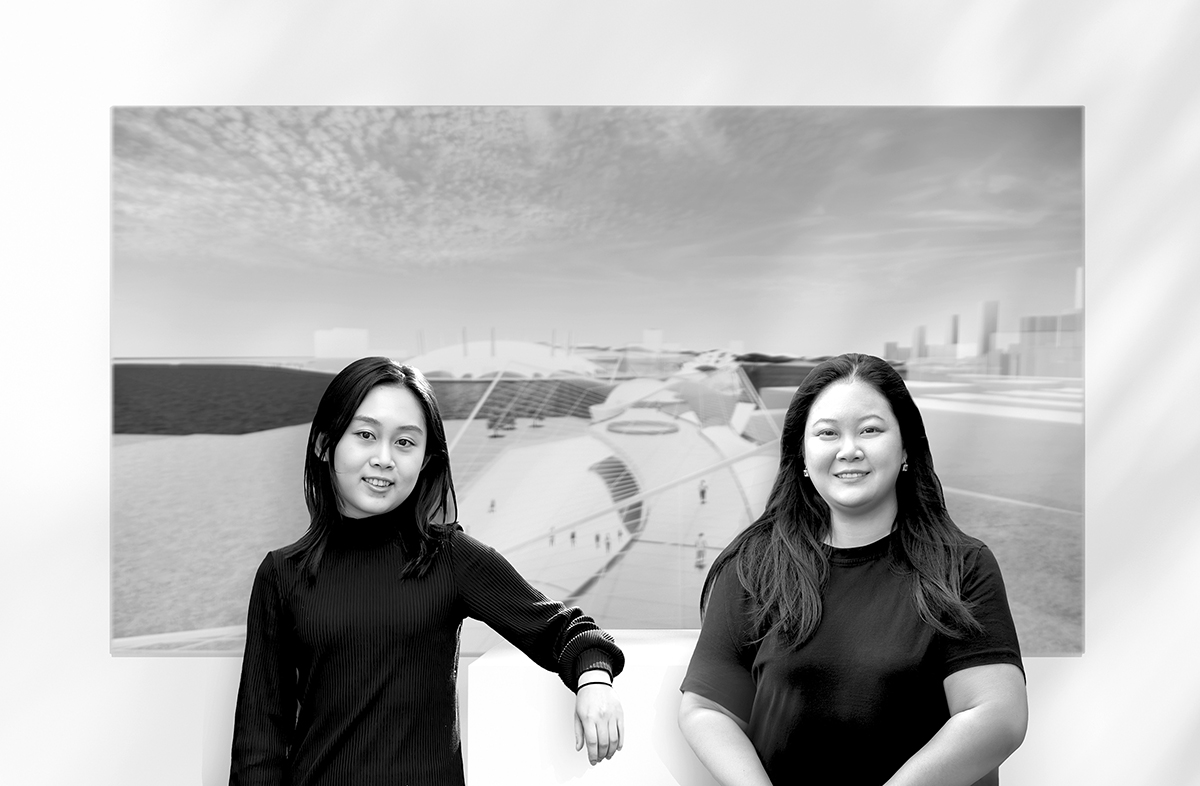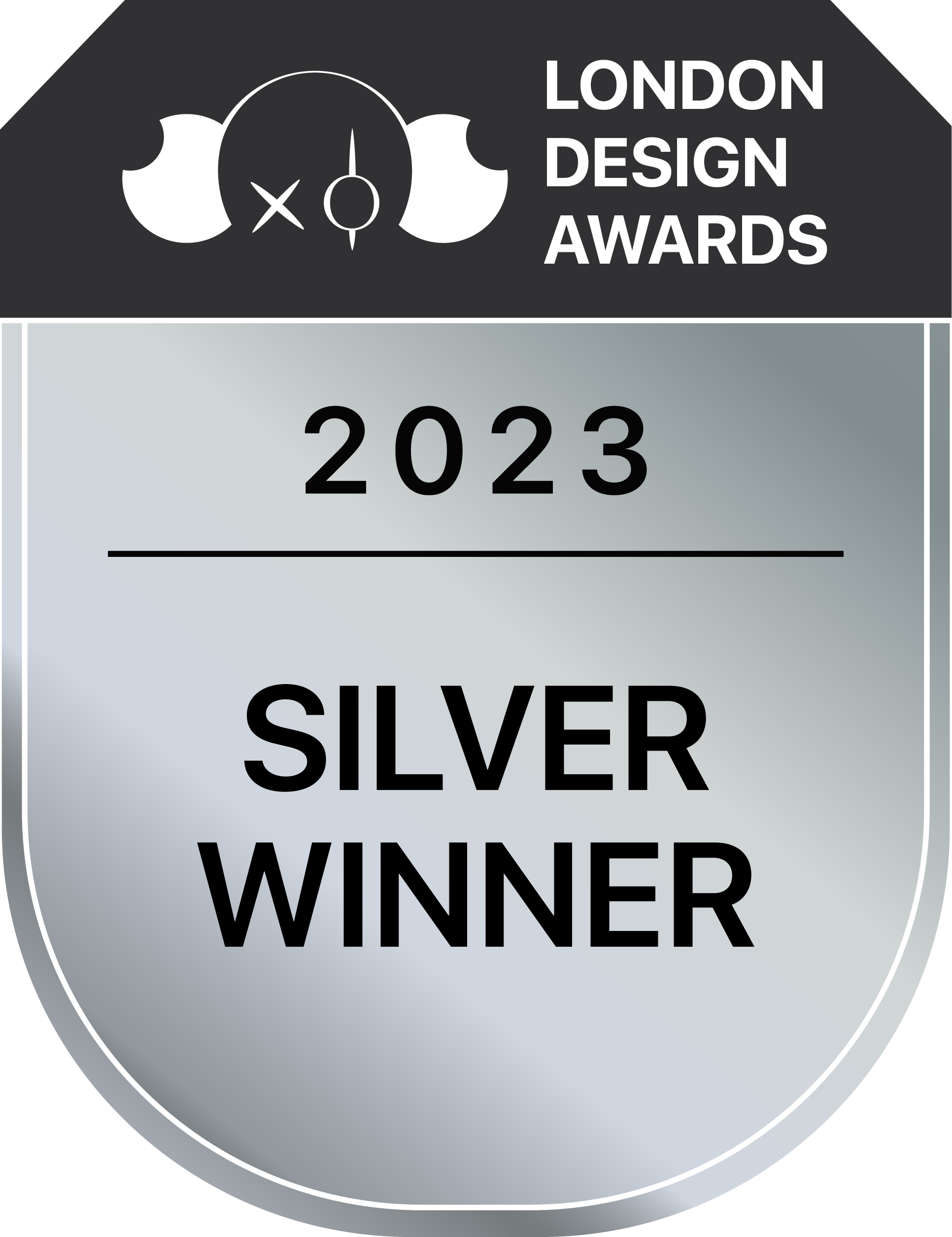
Ruichen Xu and Yunshi Chen
1. Please give us a brief bio of yourself and your design background.
Ruichen Xu and Yunshi Chen, after graduating from the University of Pennsylvania in 2021 with an 8-year Architecture study, are working as Architectural Designers in the US. We are focusing on using traditional architectural ways to seek resolutions to social issues like post-pandemic architecture. We focus on pop-art installation, regional topics, adaptive use, and affordable housing development in megacities. Our studies in architecture grant a unique perspective along with experimental concept designs to explore possibilities and feasible resolutions for such topics. We hope architecture can help designers express both their understanding of the world and their expectations for a better world.
2. What made you become/why did you choose to become a designer/artist?
Starting with an architecture major, we started our journey by interpreting this practical industry with continuous architectural tasks. 100% of the tasks are seeking solutions to real social issues and personal requirements for specific locations, programs, and functions according to the client. Since we are always considering feasible and practical solutions, we did not realize that Art has been instinctively integrated with Architecture. Unfortunately, we believe that architectural products are to some extent different from other types of art productions. However, with the progress of our study in Architecture and learning more styles and possibilities in this field, we get to understand that Art and Architecture emerge simultaneously. Since then, we have focused more on designing spaces practically and aesthetically. We believe that working as an architecture designer is the most efficient way to achieve our goal. Eventually, our proud project, Breach As A Bridge, was designed and awarded at the 2023 London Design Awards.
3. Tell us more about your agency/company, job profile, and what you do.
Ruichen Xu is working as an Architectural Designer at AECOM Technical Services, Inc. in Denver, Colorado. She works on federal projects and has a lot of experience on public projects and DoD projects. Ruichen serves for programming, design development, construction documents, and other design tasks. Yunshi Chen is working as an Architectural Designer at MENG Architects. She serves as a designer for all phases from pre-design through construction.
4. What does “design” mean to you?
We always believe that Architecture is an extraordinary and eternal way of expressing Design. You can never separate design from a building, no matter if it is a small shelter or a magnificent skyscraper. All details live in architecture and evoke itself in the world with its voice as architecture. Similarly, we architects translate our thinking and understanding of the world using the language of architecture. Trying to create a dialogue with the user and also the visitor of the building by inserting our vision and expectation of the world. After almost 8-year of Architecture study, Architecture, and Design have become our new way of communication, not only between us two but also with other people in different fields. Especially, we are all working as an architect in different cities, creating designs that almost penetrate every second of our life. After doing practical architectural projects, we get to learn more about how Design and Architecture are powerful and how much we should be responsible. Architecture could not only serve as a functional shelter, a beautiful eye candy, or even a Rolex for someone's inordinate vanity but more like a help offering to the client to improve their lives with our professional strategies. We have seen a building making an effort for the regeneration of the whole community. We have also witnessed a museum helping the country recover from the post-industrial era and bringing billions of dollars only depending on a single museum. Design and Architecture is more like our entire life.
5. What’s your favorite kind of design and why?
We prefer designs that can help improve the world. Architecture has been a rigid demand for people for thousands of years. Therefore, the purpose of architectural productions, namely buildings, must be habitable as the most important aspect for architects to consider. We hope our design can help the users solve some common problems and lead them to live a better life. This is a constant goal that we want to achieve in our way of design.
6. To you, what makes a “good” design?
It is hard to set up a standard for architectural design. The judgment for architecture is always a vague field that 1001 different answers could come from 1000 people. We insist that everyone can make their comment on any architecture while good designs are those buildings that can offer good feelings and experiences to the users. However, we believe that the feedback system is always parallel with the design process. Architects and designers would never aim to design a "good" design before it is built or published to the public. Our goal is to offer a good experience and smooth the user's life.
7. How did you come up with the idea for your award-winning design?
We believe that Architecture is an extraordinary and eternal way of understanding the world. Trying to create a dialogue with the user of the building by inserting our vision and expectation of the world. We envision the post-COVID life of London over the River Thames with the unique tool - Architecture - and explore possible solutions to the possible changes in people's behavior and even mental barriers because of COVID. This project is a contemporary simulation of the changes happening with social distances and public activities when people are more open to enjoying the outside world again. We are more open to the programs on the bridge we designed, and the spaces created by the bridge are not acting as constraints to size people in particular areas but offer more freedom for them to explore the precious space on the bridge. In this way, we believe that we are respecting the users of the architecture and spreading positive influences on the world.
8. What was your main source of inspiration for this design?
Our key takeaway from Rosalind Krauss's Klein Diagram is to resist defining a domain. The tensions between the pair happen at the periphery where architecture, non-architecture, landscape, non-landscape, structure, and non-structure coexist. The ambiguity between each of the two terms generates the concept that a mixture of landscape, structure, and architecture can be in a formal expression. Habitable Topography, the artificial topos weaving and interacting creating the space consisting of Architecture and Landscape. The orientation of the bridge is to challenge the existing segregated districts in zoning and propose an idea of
9. Do you think your country and its cultural heritage has an impact on your design process?
Definitely. We were inspired by traditional Chinese bridge design. In ancient China, bridges are spaces for commercial, residential, and recreational programs. People gather on the bridge to see what is happening on the stream flowing below it. Romantic stories happen on the bridges while thriller scenes happen on the same spot as well. We admire the diversity and possibilities that bridge can bring to us. In our design, we inherited this traditional trend and incorporated it with our vision for the new living patterns in the post-pandemic era after 2020. With openness and flexibility in any of the spaces on the bridge to accommodate people
10. Congratulations! As the winner of the London Design Awards, what does it mean to you and your company and team to receive this award distinction?
We are thankful and feel honored to be selected and awarded at the London Design Awards. This is an encouragement to us and a recognition of our design. We are still in our early career and this award means a lot to us. On the road to design, it is hard and stiff to persist in testing designs and doing experiments. This design is our first try to utilize architecture as a cure to the new world after the pandemic which received such a big recognition from the jury. Thank you again for offering us this honor and thank you for holding this Award!
11. Can you explain a bit about the winning work you entered into the London Design Awards, and why you chose to enter this project?
When we talk about London, we are talking about the River Thames. We were envisioning the post-COVID life of London over the River Thames with the unique tool - Architecture - and exploring possible solutions to the possible changes in people's behavior and even mental barriers because of COVID. This project is a contemporary simulation of the changes happening with social distances and public activities when people are more open to enjoying the outside world again. We are more open to the programs on the bridge we designed, and the spaces created by the bridge are not acting as constraints to size people in particular areas but offer more freedom for them to explore the precious space on the bridge. In this way, we believe that we are respecting the users of the architecture architecturally.
12. What were the main challenges you faced during the design process, and how did you overcome them?
We were afraid of being too bold when designing this bridge. Who has imagined designing a bridge that can hold thousands of people and bike on that! We came up with this idea and only hesitated for one second. During the design process, we worked hard on modeling all spaces and tried our best to test the possibilities for every specific space. We imagined being in the space physically and tried to feel the space. Eventually, it is awarded!
13. How do you think winning this award will impact your future as a designer?
We feel grateful for this award. In the future, we will take this award as a light that can lighten our future road of design. Whenever we feel tired or confused, we will think of this moment and keep going. We wish to create more "good" designs and help more people on this planet.
14. What are your top three (3) favorite things about the design industry?
Architecture studios, architects, and London Design Awards.
15. What sets your design apart from others in the same category?
We want to be really humble on this question. As we have mentioned in the answer to the standard for "good" design, we cannot set up a standard nor judge others' designs. The only thing we can do is to express our focus which are regional topics, adaptive use, and affordable housing development. We hope that more and more good architects will have more opportunities to design and build more and more impressive buildings and bridges.
16. Where do you see the evolution of design industry going over the next 5-10 years?
Due to the basic principles in the architecture design field, almost all buildings and projects are driven by the client's aesthetic preferences and the capital market since we would not be the ones who pay to build the concrete monsters. So this fact somehow places restrictions on architects' possibilities of representing themselves and applying enough thoughts and art expressions to it. Furthermore, more and more new techniques are being invented that are popular to be applied in the traditional architecture industry like the AR/VR experience applying for providing immersive experiences for both architects and clients, 3D printing, and other new model-making techniques gradually replacing the human model-makers and forcing architects to learn more and more software and modeling techniques. Also, the Metaverse is creating new challenges and possible futures for architecture to be
17. What advice do you have for aspiring designers who want to create award-winning designs?
We fight when we design. More discussion would result in better outcomes. We also believe that the moment you stand for the users of the building you design, your design will always evolve in the correct way.
18. What resources would you recommend to someone who wants to improve their skills in the design industry?
We recommend getting involved in the designer community and communicating with talents in the field. One person may not be able to create as good a design as a team.
19. Tell us something you have never told anyone else.
We fought a lot when designing this project. Lol.
20. Who has inspired you in your life and why?
We are inspired by Zaha Hadid a lot in both design and our life. As female designers, we are facing similar challenges in school and our careers. Her excellent design and life experiences help us overcome obstacles one after another. Since then, we hope we can become more and more excellent and help more new designers enter a broader world of design with more freedom and fun.
21. What is your key to success? Any parting words of wisdom?
We will say persistence. Rome was not built in a day, they say. Design is not developed in one day, one month, or even one year. We need to try infinite times, create a billion plans, and finally come out with one design that we are proud of. So please do not hesitate and do not feel afraid. Test, try, and start over. You will get what you want.
22. Do you have anything else you would like to add to the interview?
We are impressed by the London Design Awards which is extremely professional when organizing the award. You broke tons of the barriers that we architects would face when presenting our projects to people who may not be familiar with the industry. We are thankful and feel honored to be awarded.


